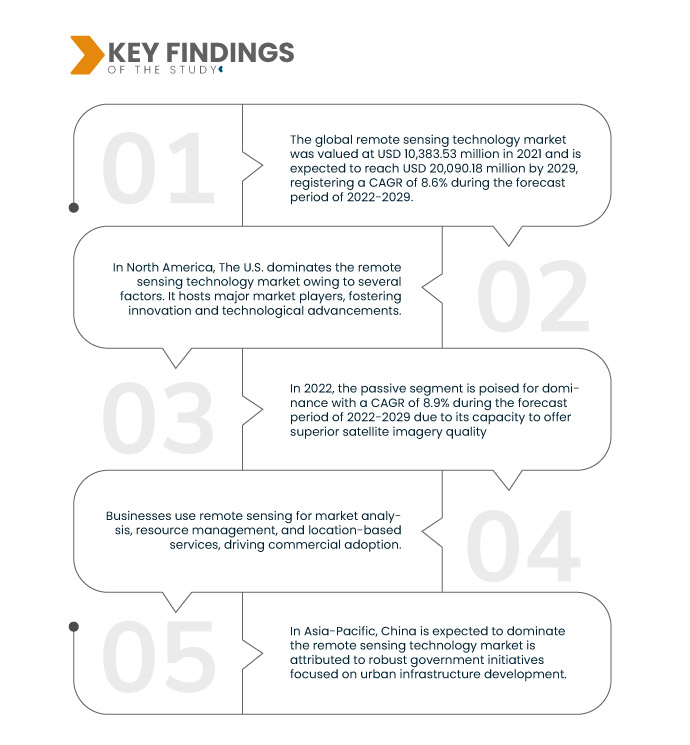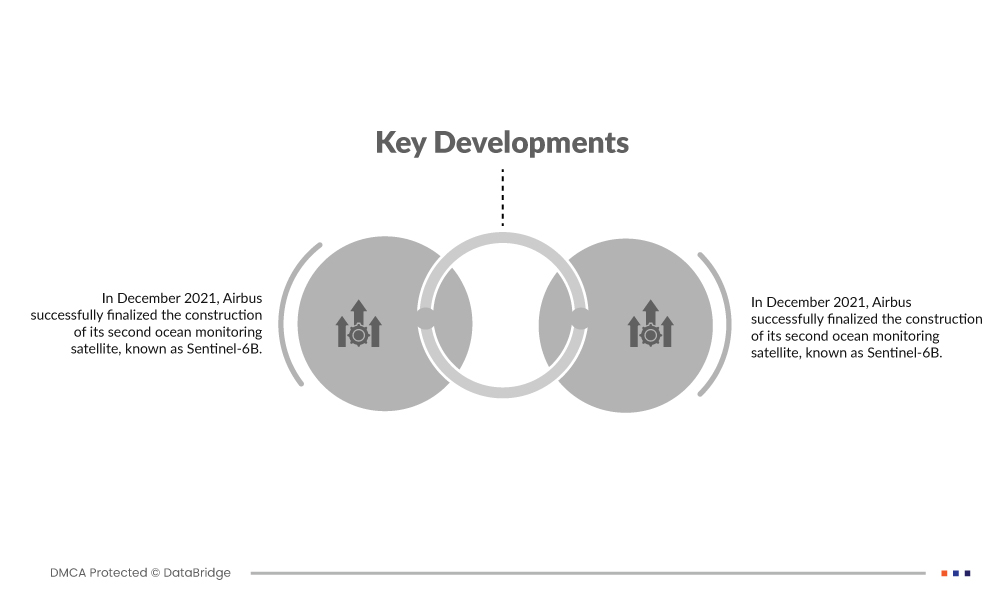Remote sensing technology finds diverse applications in agriculture, environmental monitoring, defense, and urban planning. Its dominating segment is in Earth observation and environmental monitoring. Remote sensing technology, including satellites and drones, plays a pivotal role in collecting critical data for climate monitoring, natural resource management, disaster response, and ecosystem assessment. This segment continues to expand due to growing environmental concerns and the need for data-driven decision-making.
Access Full Report @ https://www.databridgemarketresearch.com/reports/global-remote-sensing-technology-market
Data Bridge Market Research analyses that the Global Remote Sensing Technology Market was valued at USD 10,383.53 million in 2021 and is expected to reach USD 20,090.18 million by 2029, registering a CAGR of 8.6% during the forecast period of 2022-2029. In construction and infrastructure, remote sensing technology aids in selecting optimal project sites, planning layouts, and monitoring progress. It provides valuable data on topography, environmental factors, and changes during construction, enhancing project efficiency and cost-effectiveness.
Key Findings of the Study
Agriculture and precision farming are expected to drive the market's growth rate
Precision agriculture harnesses remote sensing data to revolutionize farming practices. By analyzing data from satellites and drones, farmers can pinpoint variations in soil quality, crop health, and moisture levels across fields. This knowledge enables precise adjustments in irrigation, fertilization, and resource allocation, leading to increased crop yields and reduced resource wastage. Remote sensing plays a vital role in sustainable and efficient agriculture, ensuring that resources are utilized optimally to enhance productivity.
Report Scope and Market Segmentation
|
Report Metric
|
Details
|
|
Forecast Period
|
2022 to 2029
|
|
Base Year
|
2021
|
|
Historic Years
|
2020 (Customizable to 2014-2019)
|
|
Quantitative Units
|
Revenue in USD Million, Volumes in Units, Pricing in USD
|
|
Segments Covered
|
Type (Passive and Active), System Type (Visual Remote Sensing System, Infrared Remote Sensing, Optical Remote Sensing, Microwave Remote Sensing, Radar Remote Sensing, Airborne Remote Sensing, Satellite Remote Sensing, and Acoustic, And Near-Acoustic Remote Sensing), Image Resolution (Low Spatial Resolution Sources (> 30 Meters), Medium Resolution Satellite (5-30 Meters), High Resolution Industry (1-5 Meters), and Very High Resolution Industry (< 1 Meter)), Application (Landscape Assessment, Security, Air Quality, Hydrology, Forestry, Floodplain Mapping And Emergency Management, Healthcare, Geology And Mineral Exploration, Oceanography, Agriculture and Others)
|
|
Countries Covered
|
U.S., Canada and Mexico in North America, Germany, France, U.K., Netherlands, Switzerland, Belgium, Russia, Italy, Spain, Turkey, Rest of Europe in Europe, China, Japan, India, South Korea, Singapore, Malaysia, Australia, Thailand, Indonesia, Philippines, Rest of Asia-Pacific (APAC) in the Asia-Pacific (APAC), Saudi Arabia, U.A.E, South Africa, Egypt, Israel, Rest of Middle East and Africa (MEA) as a part of Middle East and Africa (MEA), Brazil, Argentina and Rest of South America as part of South America
|
|
Market Players Covered
|
Northrop Grumman (U.S.), The Airborne Sensing Corporation (U.S.), ITT Inc. (U.S.), Leica Geosystems AG - Part of Hexagon (Switzerland), Lockheed Martin Corporation (U.S.), Honeywell International Inc. (U.S.), Thales Group (France), Orbital Insight (U.S.), Ceres Imaging (U.S.), Satellite Imaging Corporation (U.S.), Descartes Labs, Inc. (U.S.), Astro Digital US (U.S.), SlantRange, Inc. (U.S.), Droplet Measurement Technologies (U.S.), Airbus (Netherlands), Farmers Edge Inc. (Canada), SCANEX Group (Russia), SpaceKnow (U.S.), Raytheon Technologies Corporation (U.S.), Terra Remote Sensing (Canada), PrecisionHawk (U.S.)
|
|
Data Points Covered in the Report
|
In addition to the insights on market scenarios such as market value, growth rate, segmentation, geographical coverage, and major players, the market reports curated by the Data Bridge Market Research also include in-depth expert analysis, geographically represented company-wise production and capacity, network layouts of distributors and partners, detailed and updated price trend analysis and deficit analysis of supply chain and demand.
|
Segment Analysis:
The remote sensing technology market is segmented into four notable segments which are based on the type, system type, image resolution and application.
- On the basis of type, the global remote sensing technology market is segmented into active and passive. In 2022, the passive segment is poised for dominance with a CAGR of 8.9% during the forecast period of 2022-2029 due to its capacity to offer superior satellite imagery quality.
In 2022, the passive segment of type segment is anticipated to dominate the global remote sensing technology market
In 2022, the passive segment is poised for dominance with a CAGR of 8.9% during the forecast period of 2022-2029 due to its capacity to offer superior satellite imagery quality. This technology is extensively applied in earth observation, capturing detailed and high-resolution data, making it a preferred choice across various industries for monitoring and studying our planet's dynamic processes.
- On the basis of system type, the remote sensing technology market is segmented into visual remote sensing system, infrared remote sensing, optical remote sensing, microwave remote sensing, radar remote sensing, airborne remote sensing, satellite remote sensing, and acoustic, and near-acoustic remote sensing. In 2022, the radar remote sensing segment is set to lead the market with a CAGR of 9.8% during the forecast period of 2022-2029 due to its ability to transmit and receive clear, noise-free radio signals.
In 2022, the radar remote sensing segment of system type segment is anticipated to dominate the global remote sensing technology market
In 2022, the radar remote sensing segment is set to lead the market with a CAGR of 9.8% during the forecast period of 2022-2029 due to its ability to transmit and receive clear, noise-free radio signals. This technology is highly effective in propagating and communicating data, making it a prominent choice for applications that require precise and reliable information retrieval, such as environmental monitoring and defense systems.
- On the basis of image resolution, the remote sensing technology market is segmented into low spatial resolution sources (> 30 meters), medium resolution satellite (5-30 meters), high resolution industry (1-5 meters), and very high resolution industry (< 1 meter). In 2022, sources with low spatial resolution (>30 meters) are projected to lead the market with a CAGR of 9.0% during the forecast period of 2022-2029. They are preferred for their exceptional flame retardant properties and versatility in various industrial applications, making them a top choice for industries where fire resistance is a critical factor.
- On the basis of application, the remote sensing technology market is segmented into landscape assessment, security, air quality, hydrology, forestry, floodplain mapping and emergency management, healthcare, geology and mineral exploration, oceanography, agriculture, and others. In 2022, the landscape assessment segment is poised for market dominance with a CAGR of 9.6% during the forecast period of 2022-2029 as it plays a pivotal role in ensuring sustainable management and development of landscapes. This approach is vital for responsible land use, conservation, and environmental planning, making it a key component in various industries.
Major Players
Data Bridge Market Research recognizes the following companies as the major global remote sensing technology market players in global remote sensing technology market Northrop Grumman (U.S.), The Airborne Sensing Corporation (U.S.), ITT Inc. (U.S.), Leica Geosystems AG - Part of Hexagon (Switzerland), Lockheed Martin Corporation (U.S.), Honeywell International Inc. (U.S.), Thales Group (France), Orbital Insight (U.S.), Ceres Imaging (U.S.), Satellite Imaging Corporation (U.S.), Descartes Labs, Inc. (U.S.), Astro Digital US (U.S.), SlantRange, Inc. (U.S.).
Market Developments
- In December 2021, Airbus successfully finalized the construction of its second ocean monitoring satellite, known as Sentinel-6B. This advanced satellite is specifically designed to precisely measure the distance to the sea surface with an accuracy of a few centimeters. Its primary mission revolves around the meticulous assessment of sea surface heights, monitoring fluctuations in ocean levels, and observing and analyzing ocean currents to enhance our understanding of Earth's oceans.
- In January 2022, Northrop Grumman Corporation achieved a significant milestone by successfully conducting a static test of the precision strike missile rocket motor. This test served as a crucial validation step for the company's motor design as part of the production process. Northrop Grumman's commitment to digital technologies plays a pivotal role in making tactical solid rocket motor production facilities more cost-effective, modern, and efficient, ensuring the affordability of their products.
Regional Analysis
Geographically, the countries covered in the major global remote sensing technology market report are U.S., Canada and Mexico in North America, Germany, France, U.K., Netherlands, Switzerland, Belgium, Russia, Italy, Spain, Turkey, Rest of Europe in Europe, China, Japan, India, South Korea, Singapore, Malaysia, Australia, Thailand, Indonesia, Philippines, Rest of Asia-Pacific (APAC) in the Asia-Pacific (APAC), Saudi Arabia, U.A.E, South Africa, Egypt, Israel, Rest of Middle East and Africa (MEA) as a part of Middle East and Africa (MEA), Brazil, Argentina and Rest of South America as part of South America.
As per Data Bridge Market Research analysis:
North America dominates global remote sensing technology market during the forecast period 2022 - 2029
In North America, The U.S. exerts dominates the remote sensing technology market owing to several factors. It hosts major market players, fostering innovation and technological advancements. Additionally, the country widely adopts remote sensing technology across various applications, including agriculture, defense, environmental monitoring, and urban planning. The U.S. government's investments in satellite programs and research further solidify its leadership. Its extensive utilization of remote sensing technology in both the public and private sectors reinforces its prominent position in the market.
Asia-Pacific is expected to dominate the global remote sensing technology market during the forecast period 2022 - 2029
In Asia-Pacific, China is expected to dominate the remote sensing technology market is attributed to robust government initiatives focused on urban infrastructure development. The Chinese government invests heavily in satellite programs, Earth observation, and smart city projects, driving the demand for remote sensing technology. This strategic emphasis on urban development positions China as a major player, leveraging remote sensing data for efficient planning, monitoring, and management of rapidly growing cities. This proactive approach contributes significantly to China's expected leadership in the market.
For more detailed information about the global remote sensing technology market report, click here – https://www.databridgemarketresearch.com/reports/global-remote-sensing-technology-market












